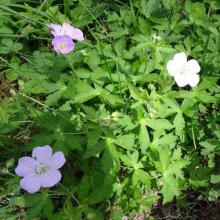Geranium maculatum
Common name:
Wild geranium
Genus:
Geranium
Family:
Geraniaceae
Order:
Geraniales
Geranium maculatum
Common name:
Wild geranium
Genus:
Geranium
Family:
Geraniaceae
Order:
Geraniales
Geranium maculatum
Common name:
Wild geranium
Genus:
Geranium
Family:
Geraniaceae
Order:
Geraniales
Family (Plantae): Geraniaceae
Geraniaceae is a family of flowering plants placed in the order Geraniales. The family name is derived from the genus Geranium. The family includes both the genus Geranium (the cranesbills, or true geraniums) and the garden plants called geraniums, which modern botany classifies as genus Pelargonium, along with other related genera.
The family comprises 830 species in five to seven genera. The largest genera are Geranium (430 species), Pelargonium (280 species) and Erodium (80 species).
Description
Geraniaceae are herbs or subshrubs. The Sarcocaulon are succulent, but other members of the family generally are not.
Leaves are usually lobed or otherwise divided, sometimes peltate, opposite or alternate and usually have stipules.
The flowers are generally regular, or symmetrical. They are hermaphroditic, actinomorphic (radially symmetrical, like in Geranium) or slightly zygomorphic (with a bilateral symmetry, like in Pelargonium). The calyx and the corolla are both pentamerous (with five lobes), petals are free while sepals are connate or united at the base. The androecium consists in two whorls of five stamens each, some of which can be unfertile; the pistil consists of five (less commonly three) merged carpels. The linear stigmas are free, and the ovary is superior. The nectaries are localized at the bases of the antesepalous stamens and are formed by the receptacle. Pelargonium has only one nectary gland on the adaxial side of the flower. It is hidden in a tube-like cavity which is formed by the receptacle. Flower morphology is conserved within Geraniaceae, but there is a large diversity in floral architecture. Flowers are usually grouped in cymes (e.g. in Geranium), umbels (e.g. in Pelargonium) or, more rarely, spikes.
Geraniaceae are normally pollinated by insects, but self-pollination is not uncommon.
The fruit is a unique schizocarp made of five (or three) achenes, in the lower part the achenes are inside the calyx, while the upper part (the stylar beak) is the style of the flower, looking like a kind of long beak over the achenes. When the fruit is mature the style breaks into five (or three) hygroscopically active (ready to absorb water) bristles that curl, causing the achenes to be released.
Reference: Wikipedia

